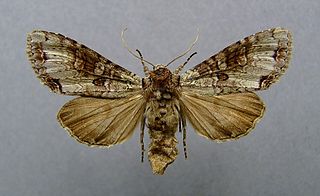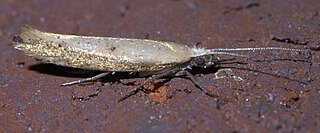Related Research Articles

Apamea crenata, known as the clouded-bordered brindle, is a moth in the family Noctuidae. It is distributed throughout the Palearctic realm. In the North it crosses the Arctic Circle, in the Mediterranean it is found only in cool locations and mountains avoiding very hot areas. In the Alps, it rises to an altitude of about 2000 metres.

Cataclysta lemnata, the small china-mark, is a moth species of the family Crambidae. It is found in Europe, Morocco and Iran.

Ypsolopha scabrella, the wainscot hooktip or wainscot smudge, is a moth of the family Ypsolophidae. The species was first described by Carl Linnaeus in 1761. It is found in Europe, China, Russia, Asia Minor and mideast Asia.

Cucullia argentea, the green silver-spangled shark, is a moth of the family Noctuidae. The species was first described by Johann Siegfried Hufnagel in 1766. It is found in southern and central Europe through Siberia, Mongolia and Manchuria up to Korea and Japan.

Mesapamea secalis, the common rustic, is a moth of the family Noctuidae. The species was first described by Carl Linnaeus in his 1758 10th edition of Systema Naturae. It is found in Europe, north-west Africa, Turkey and northern Iran.

Polia hepatica, the silvery arches, is a moth of the family Noctuidae. The species was first described by Carl Alexander Clerck in 1759. It is found in temperate Europe and east across the Palearctic to Siberia and Korea. It is not present in northernmost Fennoscandia and the southern parts of the Iberian Peninsula, Italy and Greece. It is also absent from Japan.
Ypsolopha barberella is a moth of the family Ypsolophidae. It is known from the United States, including Arizona, Nevada and Utah.

Ypsolopha unicipunctella is a moth of the family Ypsolophidae. It is known from the United States, including Oklahoma, Texas and Arizona.
Ypsolopha oliviella is a moth of the family Ypsolophidae. It is known from the United States, including Arizona.
Ypsolopha arizonella is a moth of the family Ypsolophidae. It is known from the United States, including Arizona.
Ypsolopha schwarziella is a moth of the family Ypsolophidae. It is known from the United States, including Arizona, Utah and California.
Ypsolopha striatella is a moth of the family Ypsolophidae. It is known from the United States, including California.
Ypsolopha delicatella is a moth of the family Ypsolophidae. It is known from the United States, including Arizona and California.
Ypsolopha cockerella is a moth of the family Ypsolophidae. It is known from the United States, including New Mexico.
Ypsolopha nella is a moth of the family Ypsolophidae. It is known from the United States, including Arizona and Utah.
Ypsolopha querciella is a moth of the family Ypsolophidae. It is known from the United States, including Arizona and Utah.
Ypsolopha walsinghamiella is a moth of the family Ypsolophidae. It is known from the United States, including Arizona and California.
Ypsolopha buscki is a moth of the family Ypsolophidae. It is known from the United States, including Arizona.
Gnorimoschema coquillettella is a moth in the family Gelechiidae. It was described by August Busck in 1902. It is found in North America, where it has been recorded from California and Colorado.
Nealyda kinzelella is a moth of the family Gelechiidae. It was described by August Busck in 1900. It is found in North America, where it has been recorded from Florida.
References
- ↑ nearctica Archived January 14, 2011, at the Wayback Machine
- ↑ mothphotographersgroup
- ↑ Description of American Moths of the Genus Cerostoma